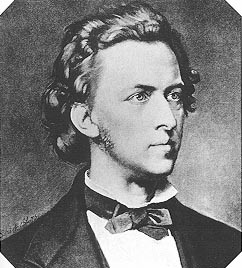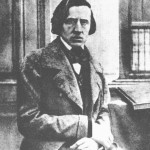Frédéric François Chopin, or Fryderyk Franciszek Chopin if you prefer the original Polish spelling of his name, shared many parallels with Wolfgang Amadeus Mozart: both were brilliant virtuosos and composers; both were child prodigies and both made their names in great capitals of Europe (Paris and Vienna respectively), both were very short of money in their lifetimes, and both died tragically early deaths in their 30s (39 and 35 in fact) leaving an astonishing legacy of some of the most beautiful music ever written in any genre.
There the similarity ends. Chopin’s genius was on the piano, and the vast majority of his oeuvre was composed for solo piano where Mozart experimented with all music formats and worked his way around the orchestra and composed many full-scale operas.
Chopin’s genius on the piano was matched by his composition, where he took many of the common forms of the day – sonata, polonaise, mazurka, nocturne, impromptu, étude, waltz, nocturne, scherzo, prélude and so on – and innovated them into something entirely revolutionary, much as Beethoven had done with the sonata some years before. Chopin also invented the instrumental ballade, and for good measure also composed two piano concertos and assorted other pieces.
That Chopin’s pieces were the very epitome of the romantic movement is beyond question, following in the steps of the more romantic passages from Beethoven and Brahms. In another era he might have adopted a completely different style, but for his time, Chopin composed sublimely beautiful romantic pieces that sound incredibly fresh and vibrant to this day. To my ear Chopin is one of very few composers who could take a single instrument and make it sing!
His romanticism is to the fore in slower pieces and lingering sections of other pieces, but the composer did with the piano things that had never been done before, nor since. Some are mere trifles, erudite whimsies, while others offer the full firework display. The flashier up-tempo sections are not merely displays of technique but in many ways the rock riffs of their day – the hooks to thrill audiences – albeit in a very sedate and mannered way. Chopin’s audiences were not stadia full of screaming fans, but his music would certainly have been played at dances and recitals of the day, and would have had listeners marvelling at what they heard – this piano music stood out from the crowd.
In fact the mood of Chopin’s work varies enormously, though they are, or at least seem to me, emotionally expressive, often brooding and elegiac, sometimes passionate and excitable, occasionally grand or solemn, at other times sly and even mischievous, but always eloquent and way ahead of their time.
Perhaps Chopin is often associated with cascading scales, usually in a minor key, finishing with a contrasting upward tone – most of his pieces contain at least one example in the main theme. There is something irresistibly addictive delightful and about these distinctive and delightful cadences which keeps me coming back for more. Far from banal repetition (as I once heard a Professor of Music describe popular music), Chopin’s themes are light, subtle, delicate, beautiful, the fingers dancing down the keys.
That said, remember that he was also responsible for Piano Sonata No. 2 in B-flat minor, Op. 35, III. Marche fun, aka The Funeral March, perhaps the Chopin answer to Mozart’s Requiem Mass, though nothing like as sombre as you might imagine – much light and shade and passion there too.
I love both Chopin and Mozart, but there is no doubt that Chopin’s music, romantic and haunting, has increasingly left me spellbound, to the extent that the ring tone on my house phone is now Chopin’s wonderful Fantasie-Impromptu, Op 66. The story behind this piece is worth repeating:
The Fantaisie-Impromptu in C-sharp minor, Opus posthumous 66, is a solo piano composition and one of his most well-known pieces. It was composed in 1834 and dedicated to Julian Fontana. Fontana published the piece in spite of Chopin’s request not to do so. The piece uses many cross-rhythms (the right hand plays sixteenth notes against the left hand playing triplets) and a ceaselessly moving note figuration and is in cut time. The opening tempo is marked allegro agitato. The tempo changes to largo and later moderato cantabile when the key changes to D-flat major, the enharmonic equivalent of the more obscure tonic major key of C-sharp major, that is, the parallel major of C-sharp minor. The piece then changes to presto (although some versions of the score incorporate a coda, meaning that the original tempo of allegro agitato is repeated) where it continues in C-sharp minor as before. It ends off in an ambiguous fantasy-like ending, in a quiet and mysterious way, where the left hand replays the first few notes of the moderato section theme, while the right hand continues playing sixteenth notes. The piece resolves and gently ends on a C-sharp major rolled chord.
What this description does not explain is that Chopin hated the piece, despite the fact that it gave him licence to display his dazzling virtuosity, such that few pianists of the day could play his pieces with anything like the same spine-tingling verve, much as Niccolò Paganini was the only violinist of his day who could play the pieces he composed. On the page they look like a horrendous mass of notes, but played the pieces sound gloriously simple and tender.
Like Mozart, you wonder what Chopin might have gone on to write had he lived to full maturity. I suspect he would have become more ambitious, been commissioned to expand his repertoire and written more orchestral works, though he would always be most at home with the piano.
For now, enjoy a few of his most wonderful pieces, most courtesy of the most sympathetic and articulate of the pianists to interpret his work, Arthur Rubenstein:
Waltz in C-sharp minor is the second work of Chopin’s opus 64 and the companion to the Minute Waltz (Op. 64, No. 1). It consists of three main themes. A tempo giusto chordal with a walking pace feel; running eighth notes, with all harmony in the left hand, and a sostenuto in the tonic major (D-flat major, enharmonic equivalent to C-sharp major). Besides the slower general pace, the melody is in quarter notes except for a few flourishes in eighth notes, giving this section the quality of an interlude before the dramatic restatement of Theme B.
Quoted from Hazel Kinscella’s “Music and Romance”
…and of course my favourite! Chopin Waltz Op. 69 No. 2 in B minor
Op.25 No.6 ‘Thirds’ Etude – almost a Chopin equivalent of Rimsky-Korsakov’s Flight of the Bumble Bee!
…and finally… Op 64 No. 1 “Minute Waltz”





Can someone recommend Bondage Gear -? Cheers xox
By way of introduction, I am Mark Schaefer, and I represent Nutritional Products International. We serve both international and domestic manufacturers who are seeking to gain more distribution within the United States. Your brand recently caught my attention, so I am contacting you today to discuss the possibility of expanding your national distribution reach.We provide expertise in all areas of distribution, and our offerings include the following: Turnkey/One-stop solution, Active accounts with major U.S. distributors and retailers, Our executive team held executive positions with Walmart and Amazon, Our proven sales force has public relations, branding, and marketing all under one roof, We focus on both new and existing product lines, Warehousing and logistics. Our company has a proven history of initiating accounts and placing orders with major distribution outlets. Our history allows us to have intimate and unique relationships with key buyers across the United States, thus giving your brand a fast track to market in a professional manner. Please contact me directly so that we can discuss your brand further. Kind Regards, Mark Schaefer, marks@nutricompany.com, VP of Business Development, Nutritional Products International, 101 Plaza Real S, Ste #224, Boca Raton, FL 33432, Office: 561-544-0719
Is anyone here in a position to recommend Women’s Briefs and Boyshorts? Cheers xxx
Hi there I am so delighted I found your weblog, I really found you by mistake, while I was searching on Google for something else, Anyhow I
am here now and would just like to say many thanks for a
tremendous post and a all round exciting blog (I also love the theme/design), I
don’t have time to read through it all at the minute but I have
bookmarked it and also added your RSS feeds, so when I have time I will be back to read more,
Please do keep up the excellent b.
Has anyone shopped at Darkside Vapors Vape Store in 626 Bedford Street?
cbd stores are called what